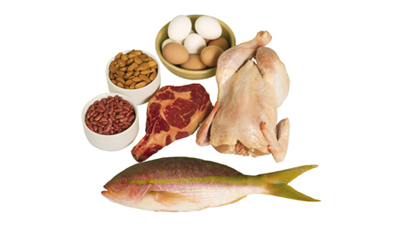
How much protein do you think you should be getting?
We all know protein is important for building muscle; however, sometimes people think their entire diet should be filled with high-protein foods. If you count yourself amongst them, you could be getting too much.
In general, the ideal diet includes 15% protein, 15% fats, and 70% carbohydrates. Diets such as the Zone diet, however, recommend a balanced caloric intake of 40% carbohydrates, 30% fats, and 30% protein. Other diets emphasize a high-protein and fat intake and low-carbohydrate intake, such as the Stillman, Mayo Clinic, Calories Don’t Count, Atkins, and Paleo diet. The main goal of these high-protein and low-carb diets is to simply lose weight.
The Paleo diet suggests that not eating enough high-protein foods can result in overeating, which is a reason why they believe high-protein foods can help with weight loss. The Atkins diet says weight loss occurs when you put your body in a state of ketosis, where you initially lose water weight. This is a little misleading because the weight you lose is not fat.
5 Health Risks of High-Protein Diet
1. Severe Dehydration
When there is an imbalance of nutrient proportions, your body will require more water. The initial weight loss of the Atkins diet is the water your body loses. The combination of water and glycogen loss can lead to dehydration. The waste from ketogenic amino acids breaks down and produces ammonia and the kidneys then eliminate urea. This can also lead to dehydration.
Severe dehydration can lead to health problems such as muscle wasting, dizziness, weakness, kidney damage, liver damage, and colon cancer. The Atkins high-protein diet therefore wouldn’t be sustainable for the long term.
2. Unbalanced Food Dynamics
The Atkins high-protein diet promotes high-protein foods that are very warming, acid-forming, and contractive. But to balance your diet, you also need to include foods that are cooling, alkalinizing, and expansive.
An acid-forming and high-protein diet consisting of mainly meat, fish, chicken, eggs, pork, bacon, and cheese could lead to emotional imbalances, dental problems, and a weak body.
Very contractive meals can lead to a lack of concentration. Acidifying and contracting foods also lead to cravings for alcohol (expansive) and junk food (alkalizing).
3. Restriction of High-Nutrient Foods
The Atkins diet recommends a very limited amount of vegetables and fruits, which is a problem because they provide a lot of nutrients that your body needs such as fiber and phytonutrients. Both the Atkins and the Paleo diets also disregard healthy whole grains and legumes.
Generally, high-protein diets ignore sea vegetables, tofu, and fermented soy products, which can provide many health benefits. There are also vitamins and minerals you would not get on a high-protein diet, which can create deficiencies.
4. Promotion of Unhealthy Foods
The Paleo diet does not allow processed foods and promotes a more natural, whole foods approach to the high-protein diet, whereas junk food is allowed on the Atkins diet as are artificial sweeteners, coffee, black tea and diet sodas, which could all cause health issues.
Atkins doesn’t restrict foods that some would consider unhealthy such as fast food or frozen dinners, as long as they don’t contain bread and are low in carbs.
5. No Restriction of Animal Type
When you eat protein, you want it to be of the best quality. You could still get that Big Mac without the bun, and that’s abiding by the diet, according to the Atkins diet.
When it comes to eating meat, the Paleo diet is healthier. It only allows grass-fed meat, free of antibiotics and steroids. Technically, you are only on the Paleo diet when you eat these organic cuts of meat.
Are high-protein foods and the high-protein diet good for you? If Paleo is done right, it has sustainable benefits; however, the Atkins high-protein diet can be very destructive to the body. I don’t think a high-protein diet is a good thing, and a balance of carbs and fat will benefit your long-term health.
Related:
Sources:
Colbin, A., Food and Healing (Toronto: Random House, 1986), 105-107.
“5 Negative High Protein Diet Effects,” Fit Day web site; http://www.fitday.com/fitness-articles/nutrition/healthy-eating/5-negative-high-protein-diet-effects.html, last accessed Feb. 7, 2014.
“High-Protein Diet Slideshow,” WebMD web site; http://www.webmd.com/diet/ss/slideshow-high-protein-diet, last accessed Feb. 7, 2014.
“What is protein?,” Atkins web site; http://www.atkins.com/Science/Nutrition-and-Exercise/Protein.aspx, last accessed Feb. 7, 2014.













